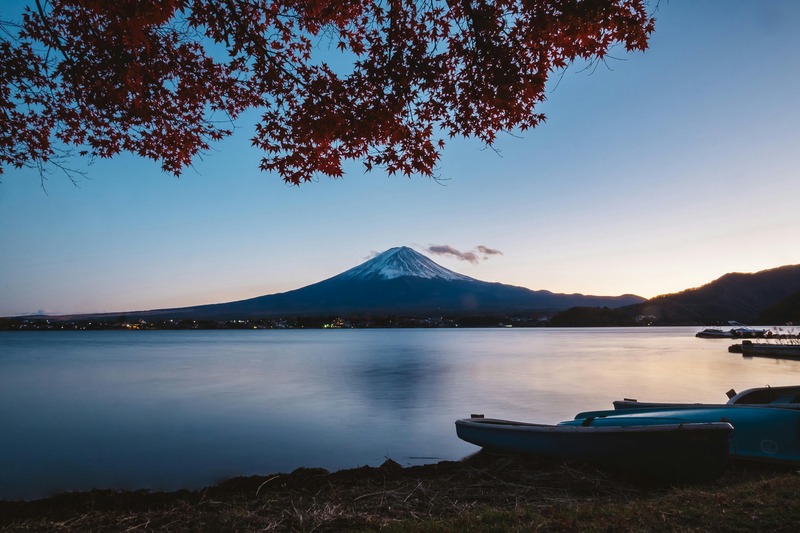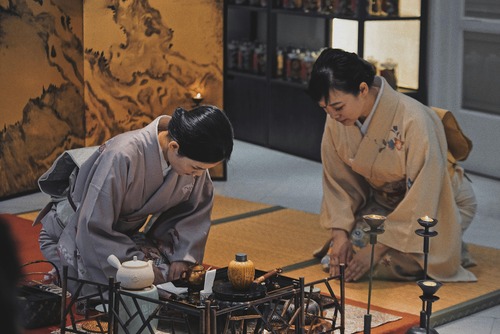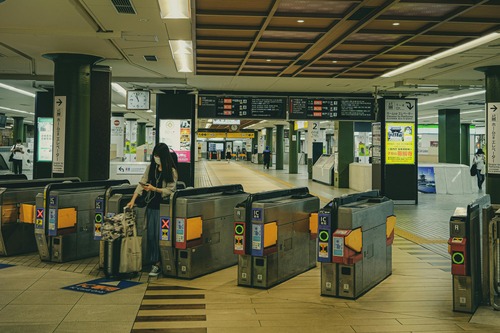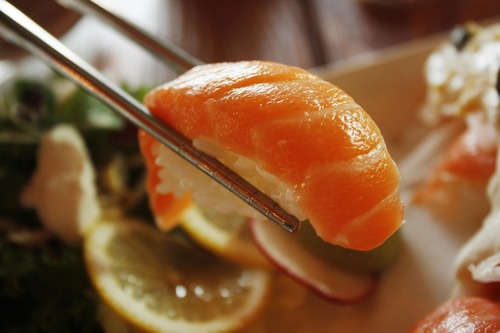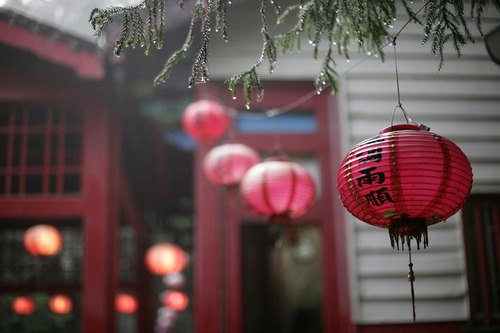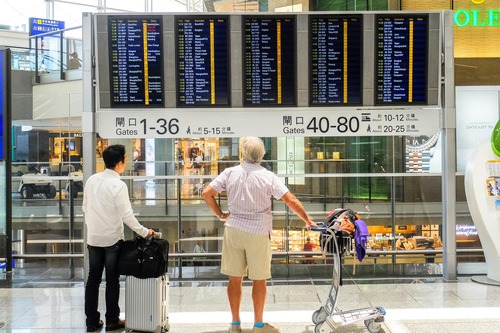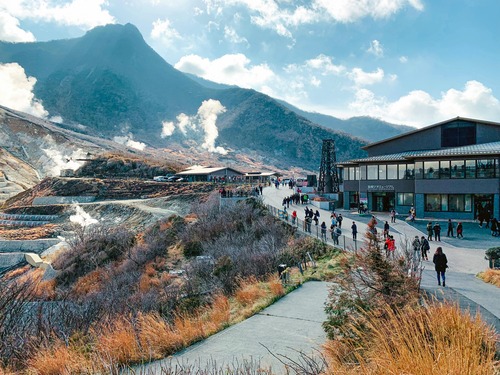Whether you’re travelling to Japan for the first time or you’re a frequent guest, this essential travel guide will arm you with the best insights and tips.
Here’s what you’ll learn:
- The best time to visit Japan and experience its breathtaking seasons, from cherry blossom spring to vibrant autumn colours (and why you may want to avoid June to mid-July)
- Tips on navigating Japan’s efficient public transportation system
- Experience Japan’s culinary delights, from sushi to ramen, and learn the essential dining etiquette (never stick your chopsticks pointing up in your rice)
- Traditional ryokans or modern hotels? Find the perfect stay for your budget and style
- Only in Japan for a short time? Here’s what we’d recommend with our 10-day itinerary
- Plus, basic packing tips, cultural etiquette insights, and language basics to get you started
Why Japan is a Perfect Destination for Your Trip
Japan has something for everyone. From the stunning cherry blossoms in spring to the colourful festivals throughout the year.
It’s famous for its delicious cuisine, unique subcultures like anime and kawaii, and breathtaking natural scenery that changes dramatically with each season.
It’s also known for being one of the safest countries in the world and boasts a highly efficient public transportation system, making it easy to explore. With new attractions like the Ghibli Park.
Plan Your Trip To Japan: Pre-Flight Checklist
Here are some quick tips for planning a trip to Japan:
Check visa requirements
- Visa-free travel is possible for citizens of 68 countries (including US, UK, Canada, Australia, and the EU) for stays of up to 90 days.
- Have a return or onward flight out of the country, as immigration may question you upon arrival.
Purchase your JR Pass (Japanese Rail Pass)
This pass is only available to foreigners, and it keeps you out of the typical commuter trains, which can get very busy. This pass is great if you want to travel around Japan, you can see all the best tourist spots and the trips are unlimited we recommend purchasing online before you arrive.
Learn some basic Japanese and
- Numbers are especially useful
- Consider using an app like Duo Lingo or watching some online videos just to get the basics down.
Arrange travel insurance
- Healthcare is expensive in Japan, so ensure you have coverage.
Apply for a Mastercard Credit or Debit Card
- Some Japanese websites don’t work with Visa, so having a backup is beneficial.
- Consider cards with free international transactions and cash withdrawals (e.g., Starling Bank debit card for UK residents).
Prepare physically
Walk as much as possible to prepare for the extensive walking in Japanese cities
Practice using chopsticks, as they are essential for dining in most restaurants
Get used to sitting on the floor for some restaurants and experiences
Buy a pre-paid transport IC card
(e.g., ICOCA, Suica, or Pasmo) for local trains, metro, and buses
Physical cards may be in short supply, so consider adding Suica to Apple Wallet on your phone or watch
Use Apple Pay, Mastercard, or American Express to top up (Visa doesn’t work as a payment method)
Set up a Travel eSIM
- So that you have instant, affordable data as soon as you hop off the plane.
- Having access to maps and Google Translate makes navigating and communicating easier.
- If your phone doesn’t support eSIMs, buy a physical Umobile SIM from a vending machine at Tokyo Narita Airport (ensure your phone is unlocked)
Research and book other attractions and restaurants in advance
The best restaurants and attractions will have a wait list so book early, we recommend 12 weeks in advance.
Check out our Travel eSIM’s for Japan and get affordable data as soon as you switch your phone on in Japan.
Catch The Best Seasons
Japan is a year-round destination, with each season offering its own unique charm.
Here’s a quick comparison of the pros and cons of each season:
- Spring (March to May): Enjoy Hanami, which is cherry blossom viewing in parks and along the riverbanks, but expect crowds and higher prices.
- Summer (June to August): Enjoy vibrant festivals and outdoor activities, but prepare for hot and humid weather.
- Fall (September to November): Admire the stunning autumn foliage and enjoy mild temperatures, making it ideal for outdoor exploration.
- Winter (December to February): Experience the magical winter wonderland, particularly in Hokkaido, and enjoy winter sports and onsen (hot spring) visits.
Consider your preferences and planned activities when deciding on the best time to visit Japan.
Japan’s Festivals and Events to Look Out For
Some of the most well-known festivals to keep an eye out for are:
Gion Matsuri in Kyoto, which is considered one of Japan’s three great festivals, features stunning processions of floats and traditional clothing in July.
Awa Odori in Tokushima, the largest traditional dance festival in Japan with a 400-year history, features groups of choreographed dancers in mid-August.
Tenjin Matsuri in Osaka, honouring the deity of scholarship with a land procession, river procession, and fireworks on July 24th and 25th.
Kanda Matsuri in Tokyo is known for its parade of portable shrines and traditional music and dance in mid-May.
Nebuta Matsuri in Aomori is famous for its large illuminated floats and energetic dances in early August.
Must-Visit Destinations: From Tokyo to Kyoto
No trip to Japan is complete without visiting these top cities and regions.
Tokyo: Japan’s vibrant capital offers a perfect mix of modern innovation and traditional charm. Don’t miss iconic attractions like the Sensoji Temple, the Meiji Shrine, and the Tsukiji Fish Market.
Kyoto: The cultural heart of Japan, Kyoto is home to numerous ancient temples, shrines, and gardens. Things to do in Kyoto include the Fushimi Inari Shrine, the Kinkakuji (Golden Pavilion), and the Gion district, famous for its geishas.
Osaka: Known for its delicious food and lively atmosphere, Osaka is a must-visit for foodies and those seeking a more laid-back vibe. Be sure to explore the Dotonbori area and visit the iconic Osaka Castle.
Hiroshima: A city with a poignant history, Hiroshima is now a symbol of peace. Visit the Peace Memorial Park and Museum, and take a day trip to the nearby Miyajima Island, famous for its floating torii gate.
A Day Trip Guide: Maximizing Your Days in Japan
Make the most of your time in Japan by taking easy day trips from major cities.
From Tokyo: Visit the stunning Mt. Fuji and the nearby Hakone region, known for its hot springs and scenic views. Another option is the coastal town of Kamakura, famous for its giant Buddha statue and beautiful beaches.
From Kyoto: Explore the charming town of Nara, home to friendly deer and the impressive Todaiji Temple. Alternatively, visit the picturesque Arashiyama district, known for its bamboo groves and scenic river.
Unique Experiences in Japan: Beyond the Tourist Trails
To truly immerse yourself in Japanese culture, seek out these unique experiences:
- Tea Ceremonies: Attend a traditional tea ceremony and learn the art of preparing and serving matcha green tea.
- Onsen Visits: Relax in a natural hot spring bath or onsen, a quintessentially Japanese experience. Many Ryokans (traditional inns) in Japan feature their own onsen facilities, perfect for relaxation during your travel in Japan.
- Off-the-Beaten-Path Destinations: Venture beyond the usual tourist trails and explore lesser-known regions like the Tohoku area in northern Japan, known for its stunning natural beauty and unique festivals.
By combining must-visit destinations with unique cultural experiences and day trips, you’ll create an unforgettable Japan itinerary tailored to your interests. Stay tuned for our next guide on navigating Japan, where we’ll share essential tips for first-time visitors on transportation, dining, and accommodation.
Navigating Japan: Travel Tips for First-Timers
Japan is a fascinating country with a unique culture, but navigating it for the first time can be overwhelming. To ensure a smooth and enjoyable trip, familiarize yourself with the country’s transportation system, dining etiquette, and accommodation options. In this guide, we’ll provide in-depth tips and advice for first-time visitors to Japan.
Getting Around: Tips on Using the Japan Rail Pass
The Japan Rail (JR) Pass is a cost-effective way to travel throughout Japan, offering unlimited rides on JR trains, including the famous Shinkansen (bullet train). Here’s what you need to know:
- Purchasing: Buy your JR Pass before arriving in Japan through authorized vendors or online. You’ll receive an exchange order, which you’ll need to convert into the actual pass at a JR office in Japan.
- Validity: The pass is available for 7, 14, or 21 consecutive days. Activate your pass at a JR office on the day you wish to start using it.
- Coverage: The JR Pass covers most JR trains, including the Shinkansen (except for the Nozomi and Mizuho trains), local trains, and some JR buses and ferries.
When using public transportation in cities, consider these tips:
- IC Cards: Purchase a rechargeable IC card, such as Suica or Pasmo, for convenient travel on subways, buses, and trains in major cities.
- Navigation Apps: Use apps like Google Maps or Hyperdia to plan your routes and check train schedules.
- Station Signs: Look for signs in English at major stations, and don’t hesitate to ask station staff for assistance if needed.
Eating Out: A Guide to Restaurants in Japan
Japan is renowned for its delicious and diverse cuisine. Here’s what you should know when dining out:
Types of Restaurants: Japan offers a wide range of dining options, from casual izakayas (Japanese pubs) to high-end sushi restaurants. Other popular choices include ramen shops, tempura restaurants, and yakiniku (grilled meat) eateries.
Ordering: Many restaurants have picture menus or plastic food displays, making it easier to order. Some restaurants also have ticket vending machines where you purchase a meal ticket before entering.
Dietary Restrictions: If you have dietary restrictions, consider carrying a card explaining your needs in Japanese. Many restaurants offer vegetarian and vegan options, but it’s always best to check in advance.
Etiquette: When eating at a restaurant, wait for the staff to guide you to your seat. Before eating, say “itadakimasu” (a phrase of gratitude). Use chopsticks for most meals, and avoid sticking them upright in your rice, as this is considered a funeral ritual.
Accommodation Tips: Where to Stay in Japan
Japan offers a range of accommodation options to suit different budgets and preferences:
Hotels: Western-style hotels are available in major cities, offering familiar amenities and services. Book in advance for the best rates.
Ryokans: Traditional Japanese inns, or ryokans, offer a unique cultural experience with tatami mat rooms, futon bedding, and onsen (hot spring) baths. Many ryokans also serve authentic Japanese meals.
Hostels & Budget Accommodations: Hostels and budget hotels are great options for travellers on a tight budget. Look for well-reviewed options in central locations for convenience.
Airbnb & Vacation Rentals: Renting an apartment or house through Airbnb or similar platforms can be a cost-effective option for groups or those seeking a more local experience.
When choosing where to stay, consider these tips:
- Location: To minimize travel time, stay in neighbourhoods with good public transportation access. Popular areas in Tokyo include Shinjuku, Shibuya, and Asakusa. In Kyoto, consider staying near Kyoto Station or in the historic Gion district.
- Amenities: Check if your accommodation offers essential amenities like Wi-Fi, air conditioning, and laundry facilities.
- Reviews: Read reviews from previous guests to gauge the quality and service of the accommodation.
By following these tips and doing your research, you’ll be well-prepared to navigate Japan with confidence as a first-time visitor. Stay tuned for our next guide on budgeting for your Japan trip, where we’ll discuss daily expenses, money-saving tips, and essential planning tools.
Budgeting for Your Japan Trip: How Much to Spend in Japan?
One of the most important aspects of planning a trip to Japan is creating a realistic budget. Japan has a reputation for being an expensive destination, but with careful planning and smart choices, you can enjoy an unforgettable trip without breaking the bank. In this guide, we’ll provide daily budget tips, suggest free and low-cost activities, and recommend essential planning tools to help you manage your travel expenses.
Daily Budget Tips for Travellers
To create a realistic daily budget, consider the following breakdown of expected costs:
- Accommodations: Budget around ¥6,000-10,000 ($55-90 USD) per night for a mid-range hotel or ryokan. Hostels and budget hotels can cost as little as ¥2,500-5,000 ($23-45 USD) per night.
- Food: Expect to spend around ¥2,000-3,000 ($18-27 USD) per day on meals, depending on your dining preferences. You can save money by eating at casual restaurants and convenience stores or even trying street food.
- Transportation: A 7-day JR Pass costs around ¥29,000 ($265 USD), which can be a cost-effective option if you plan to travel extensively by train. In cities, budget around ¥1,000-1,500 ($9-14 USD) per day for public transportation.
- Attractions: Entrance fees for temples, shrines, and museums typically range from ¥300-1,500 ($3-14 USD). Some attractions, like the Tokyo Skytree or Universal Studios Japan, can cost upwards of ¥3,000 ($27 USD).
To save money, consider these tips:
- Stay in budget accommodations like hostels or capsule hotels
- Eat at local restaurants and convenience stores instead of high-end establishments
- Take advantage of free attractions and activities (more on this below)
- Purchase a JR Pass if you plan to travel extensively by train
On the other hand, if you want to splurge strategically, consider:
- Staying in a traditional ryokan with onsen access
- Enjoying a high-end kaiseki or sushi meal
- Experiencing unique activities like a private tea ceremony or a geisha performance
Saving on Attractions: Free Things to Do in Japan
Japan offers plenty of free and low-cost activities that allow you to experience the country’s culture and beauty without spending a fortune. Some ideas include:
- Visiting free observation decks like the Tokyo Metropolitan Government Building or the Umeda Sky Building in Osaka
- Exploring beautiful parks like Ueno Park in Tokyo or Maruyama Park in Kyoto
- Joining free walking tours in major cities to learn about local history and culture
- Attending free festivals and events like the Sanja Matsuri in Tokyo or the Hakata Dontaku Festival in Fukuoka
Managing Travel Expenses: Planning Tools You Need
To keep your travel expenses under control, consider using these essential planning tools:
- Budgeting Apps: Use apps like TravelSpend or Trabee Pocket to track your daily expenses and stay within your budget.
- Currency Converter Apps: Download a currency converter app like XE Currency to quickly calculate prices and ensure you’re getting a fair exchange rate.
- Credit Cards with No Foreign Transaction Fees: To save on costs, use credit cards that don’t charge foreign transaction fees. Some cards also offer travel rewards or cash back on purchases.
When it comes to money matters, keep these tips in mind:
- Exchange some cash before arriving in Japan, but don’t carry too much as Japan is generally a safe country with low crime rates.
- Use ATMs at 7-Eleven or Japan Post Bank to withdraw cash, as they accept most international cards.
- Notify your bank and credit card company of your travel plans to avoid any issues with your cards while abroad.
By following these budgeting tips and using the right planning tools, you can create a realistic budget for your Japan trip and enjoy all the country has to offer without overspending. Stay tuned for our next guide, where we’ll provide a sample 10-day itinerary for exploring Japan’s top destinations.
10 Days in Japan: A Sample Itinerary
To help you make the most of your trip to Japan, we’ve put together a sample 10-day itinerary that covers the country’s top destinations, including Tokyo, Kyoto, and nearby attractions. This itinerary offers a mix of must-see sights and unique experiences, allowing you to fully immerse yourself in Japanese culture.
Day-by-Day Plan: Tokyo to Kyoto and Beyond
Day 1-3: Tokyo
Immerse yourself in the vibrant energy of Tokyo, starting with the bustling districts of Shinjuku and Shibuya. In Shinjuku, savour delectable Japanese cuisine at a cozy izakaya and navigate the famous scramble crossing in Shibuya, surrounded by neon lights and countless pedestrians.
Escape the urban chaos at the serene Meiji Shrine, where ancient trees and Shinto traditions create a tranquil atmosphere. Witness a traditional wedding ceremony or write your wishes on an ema prayer plaque.
In Asakusa, explore the historic Sensoji Temple, approached via the lively Nakamise Shopping Street. Cleanse yourself at the purification fountain before offering prayers at the main hall, filled with the scent of incense.
As night falls, dive into the electric nightlife and pop culture of Akihabara and Harajuku. Browse anime and manga stores, visit a quirky maid café, or try your luck at a UFO catcher in Akihabara’s “Electric Town.” In Harajuku, stroll down Takeshita Street, where trendy boutiques and cosplayers in colourful outfits await.
Day 4-6: Kyoto
Immerse yourself in the timeless beauty of Kyoto, the ancient capital of Japan. Visit the iconic Kinkakuji, the Golden Pavilion, and marvel at its brilliant gold leaf exterior shimmering in the sunlight. Explore the stunning Kiyomizu-dera, a UNESCO World Heritage site, and take in the breathtaking views from its expansive wooden stage.
Stroll through the historic Gion district, where preserved machiya houses and elusive geishas transport you to a different era. Keep an eye out for these elegant women in their exquisite kimonos as they hurry to evening engagements.
Escape to the enchanting bamboo groves of Arashiyama, where towering green stalks and dappled sunlight create an otherworldly atmosphere. Visit the nearby Tenryuji Temple, a Zen masterpiece with a stunning landscape garden.
Day 7: Nara Day Trip
Embark on a day trip to Nara, Japan’s ancient capital, and immerse yourself in its rich history and natural beauty.
Visit the awe-inspiring Todaiji Temple, home to the world’s largest bronze Buddha statue, and marvel at the grandeur of this 8th-century architectural wonder.
As you explore the temple grounds, you’ll be greeted by the friendly deer that roam freely in Nara Park. These gentle creatures, believed to be messengers of the gods, will eagerly approach you in search of special deer crackers sold by local vendors.
Take a moment to feed and photograph these adorable animals, creating unforgettable memories of your time in this enchanting city.
Day 8-9: Osaka
Dive into the vibrant atmosphere of Osaka, Japan’s foodie capital and entertainment hub. Explore the lively Dotonbori district, where dazzling neon signs and the mouth-watering aroma of street food fill the air. Sample local specialties like takoyaki (octopus balls) and okonomiyaki (savoury pancakes) from the numerous vendors lining the streets.
Take a step back in time as you visit the impressive Osaka Castle, a symbol of the city’s rich history. Marvel at the castle’s grand architecture and learn about its fascinating past, from its construction in the 16th century to its role in shaping Japan’s political landscape.
For a day of thrills and excitement, head to Universal Studios Japan, one of the country’s premier theme parks. Experience the magic of your favourite movies and TV shows come to life, from the Wizarding World of Harry Potter to the heart-pumping rides of Jurassic Park. Immerse yourself in the park’s lively atmosphere and create unforgettable memories with family and friends.
Day 10: Hakone Day Trip
Escape to the scenic Hakone region near Mount Fuji for a day of relaxation and stunning views. Unwind in a traditional onsen (hot spring) bath, letting the mineral-rich waters melt away your stress. Take a ride on the Hakone Ropeway for breathtaking vistas of Mount Fuji and the surrounding landscape. Explore the charming town of Hakone-Yumoto, browsing local shops and sampling delicious regional cuisine before returning to Tokyo, refreshed and rejuvenated.
Weekend Getaways: Day Trip from Tokyo
If you have extra time in Tokyo, consider taking these day trips to nearby attractions:
Nikko: Visit the stunning Toshogu Shrine, a UNESCO World Heritage site, and enjoy the beautiful natural scenery. Take the Tobu Railway from Asakusa Station, which takes about 2 hours.
Kamakura: Explore the historic town of Kamakura, known for its Giant Buddha statue and beautiful temples. Take the JR Yokosuka Line from Tokyo Station, which takes about 1 hour.
Extending Your Trip: Ideas for Weeks in Japan
If you have more than 10 days in Japan, consider exploring these additional regions:
Hokkaido: Japan’s northernmost island, known for its stunning natural beauty, ski resorts, and delicious seafood. Visit the capital city of Sapporo and the picturesque town of Otaru.
Okinawa: A subtropical island chain with beautiful beaches, crystal-clear waters, and unique culture. Visit the main island of Okinawa and the smaller islands like Ishigaki and Miyako for a unique experience during your travel in Japan.
Japan Alps: A scenic mountain range in central Japan known for its hiking trails, hot springs, and traditional villages. Visit the popular resort town of Takayama and the historic village of Shirakawa-go.
By following this sample itinerary and considering these additional destinations, you’ll have a well-rounded and memorable experience in Japan. Stay tuned for our final guide on must-know Japan travel tips to ensure a smooth and enjoyable journey.
Must-Know Japan Travel Tips for a Smooth Journey
Before embarking on your trip to Japan, it’s essential to familiarize yourself with some key travel tips to ensure a smooth and enjoyable journey. In this final guide, we’ll cover packing essentials, cultural etiquette, and language tips to help you navigate Japan with confidence.
Packing Essentials for Japan: What to Bring and What to Leave Behind
When packing for your Japan trip, consider the season and your planned activities. Here’s a general packing list to get you started:
- Comfortable walking shoes
- Lightweight, breathable clothing (for summer) or warm layers (for winter)
- Rain gear (umbrella or rain jacket)
- Portable charger or power bank
- Travel adapter (Japan uses 100V, 50/60Hz outlets with two flat pins)
- Cash (Japanese yen) and credit cards
- Passport and travel documents
In addition, consider these Japan-specific items:
- Pocket Wi-Fi or data SIM card for internet access on the go
- Handkerchief or small towel (often used in public restrooms instead of paper towels)
- Slip-on shoes (for easy removal when entering temples, shrines, or traditional accommodations)
- Modest clothing (for visiting religious sites)
To save space in your luggage, consider leaving behind:
- Bulky toiletries (most hotels and ryokans provide basic amenities)
- Flashy or revealing clothing (Japan tends to have a more conservative dress code)
- Large suitcases (opt for a smaller, more manageable size for easier navigation on public transportation)
Etiquette: Do’s and Don’ts When You Travel To Japan
Japan is known for its unique customs and etiquette. To be a respectful visitor, keep these do’s and don’ts in mind:
Do:
- Bow when greeting others or expressing gratitude
- Remove your shoes when entering temples, shrines, or traditional accommodations
- Use chopsticks for most meals (avoid sticking them upright in your rice, as this is considered a funeral ritual)
- Be punctual and follow established rules and procedures
Don’t:
- Speak loudly on public transportation or in public spaces
- Eat or drink while walking or on public transportation
- Leave a tip at restaurants or hotels (tipping is not a common practice in Japan)
- Touch or point at people or religious objects
When visiting temples, shrines, and public spaces:
- Dress modestly and cover tattoos if possible, especially when visiting traditional areas like Tokyo and Kyoto.
- Follow the established rules and procedures for worship or offerings
- Be respectful and avoid loud or disruptive behaviour
- Ask for permission before taking photos of people or religious objects
Language Tips: Essential Japanese Phrases for Travellers
While many Japanese people in major cities speak some English, learning a few basic Japanese phrases can go a long way in showing respect and facilitating communication. Here are some essential phrases to get you started:
- Hello: Konnichiwa (こんにちは)
- Thank you: Arigatō (ありがとう)
- Yes: Hai (はい)
- No: Iie (いいえ)
- Excuse me: Sumimasen (すみません)
- I don’t understand: Wakarimasen (わかりません)
- Where is the bathroom?: Toire wa doko desu ka? (トイレはどこですか?)
- How much is this?: Kore wa ikura desu ka? (これはいくらですか?)
To further improve your language skills, consider:
- Downloading a language learning app like Duolingo or Memrise
- Carrying a pocket phrasebook or language guide
- Using a translation app like Google Translate for on-the-go communication
By following these must-know Japan travel tips, you’ll be well-prepared for a smooth and enjoyable journey through this fascinating country. Remember to embrace the unique culture, be respectful of local customs, and don’t be afraid to step out of your comfort zone to fully immerse yourself in the Japanese experience.

